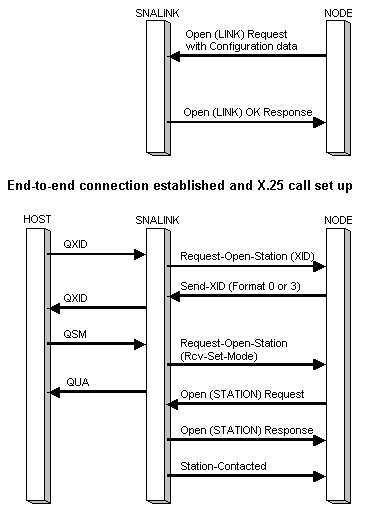
The initial sequence for a host connection over X.25, 802.2, or a switched SDLC line is similar to the sequence over a leased line. The only difference is that XIDs are exchanged before the host (or front end processor) sends a mode-setting command such as QSM on an X.25 QLLC link.
When the SNALink receives an XID, it is passed to the local node on a Request-Open-Station message (on the LINK LPI connection). The local node then passes DLC a Send-XID message (also on the LINK LPI connection) containing the XID to be sent to the host. The host typically checks the node identifier in this XID and, if it is valid, sends the mode-setting command.
The sequence is shown in the following figure.

At the link level, a mode-setting command is required to enter the information transfer state. For an SDLC link, this is an SNRM (set normal response mode); for an X.25 QLLC link, this is a QSM; for a 802.2 link, it is an SABME. If the SNALink acknowledges the command (with a UA/QUA) immediately, it needs to buffer up any data that arrives on the link in the short window before the Open(STATION) Request arrives from the local node. The alternative is to wait for the Open(STATION) Request before sending the UA/QUA response.
For switched connections using SDLC modems, the Open(LINK) Request contains dial digits for manual or auto-dial modems. It is the responsibility of the SNALink to handle the management of these devices. For X.25 and 802.2 connections, the Open(LINK) Request contains the address of the remote station.
The SNALink should initiate the dialing procedure when it receives the Open(LINK) Request.